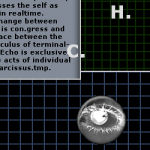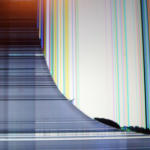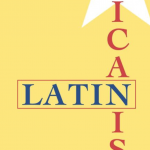2004
Gonzalo Frasca's proposal for videogames that address "critical thinking, education, tolerance, and other trivial issues."
Phoebe Sengers discusses the Expressivator and socially situated AI.
Bill Seaman hyphenates the "hybrid-languages" of Lexia to Perplexia.
Eric Zimmerman modifies Gonzalo Frasca's game strategy with a strategic patch.
2003
Reiichi Miura considers the worldwide reception of Japanese writer Haruki Murakami and charts a course for a fiction where nationalism loses relevance.
Katie King on the challenges and rewards, in her own life and the lives of her students, that emerge when writing about personal encounters with technology.
Pattern, absence, routine, return - Dave Ciccoricco mulls the shape(s) in Michael Joyce's new paper novel, Liam's Going
In looking to the future of the 'electronic book,' Ciccoricco digs up some of ebr's manifesto-like remarks of old.
Despite talk of endings and absences at Eastgate Systems, Dave Ciccoricco investigates continuities in the work of Michael Joyce and Mark Bernstein.
Rone Shavers argues that making readers aware of subjugation - the strategy of Harold Jaffe's False Positive - exposes little and hardly changes our relation to power.
A book about books conscious of their materiality, N. Katherine Hayles' Writing Machines draws praise from Raine Koskimaa for its own media consciousness, and blame for embodied emphasis.
2002
An argument against the collapse of categories by an author who has, yes, himself perpetrated a few codeworks.
Dave Ciccoricco returns to Michael Joyce's 1997 novel so as to avoid bringing hypertext criticism to a premature closure.
2001
Joseph Tabbi responds to posts from the journal design editor and publisher, using terms derived from an essay he was editing at the time. The audience database mentioned here was implemented for ebr11, wEBaRts, and further developed for the launch of End Construction! (Feb 2002)
A note on the origins and development of ebr version 3.0, End Construction!
Claire Rasmussen on geography and the social theory of Janet L. Abu-Lughod, Mike Davis, and Edward Soja.
Allison Hunter writes on Douglas Kahn, a modern musicologist who takes in the noise of modern battle, recordings from the tops of trains and the interiors of coalmines, and the musicality of undigitized everyday noise.
2000
Brian Lennon considers the aesthetic that Retallack has evolved out of a cybernetic sensibility - a formalism that does not impose authoritarian codes or repressive orders, but rather hacks a pattern out of the sheer data of everyday life: directories, menus, phone books, indexes, encyclopedias, and archives.
1999
Shirin Shenassa situates Roman de la Campa's Latin Americanism within the critical discourses of the world's metropolitan centers and introduces a new thREAD into ebr's Internet Nation series
Joseph Tabbi reads both the book and the hypertext version of Strickland's True North.





